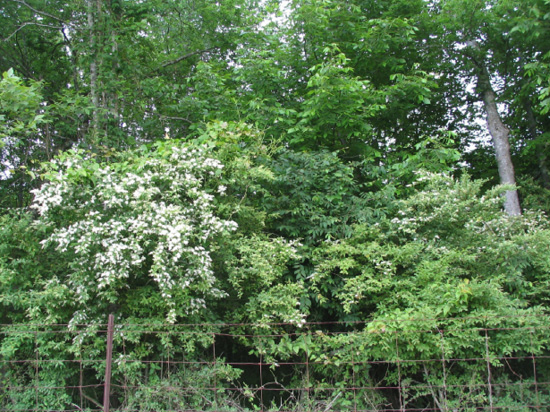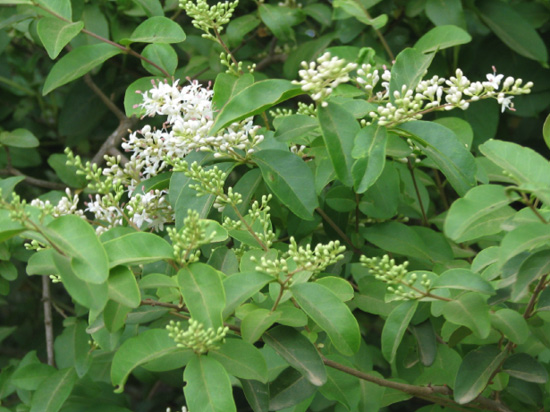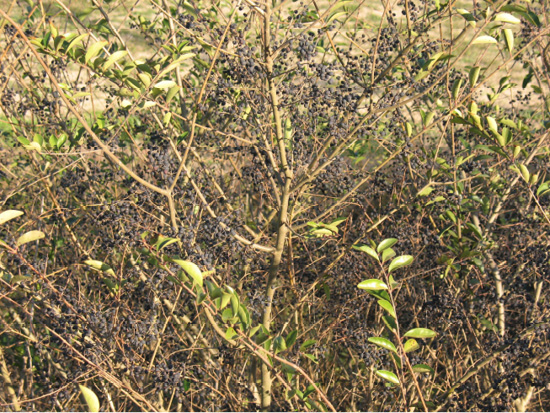Chinese Privet
Regulations
As a group, privets are so widespread that they have been omitted from federal and state noxious species legislation. In the Southeast, Chinese privet is included in all state invasive species lists. It is considered one of the top ten weeds in Alabama and Georgia; a severe threat in Kentucky, South Carolina, and Tennessee; a Category One invasive plant in Florida; and a state invasive plant in Mississippi and Virginia.
Description
Vegetative Growth
Ligustrum sinense resembles Japanese privet, L. japonicum, although the latter has larger, thicker leaves and is generally much less common in the Midsouth, though the two overlap in most of their distributions across the United States. Chinese privet is a semi-evergreen to evergreen, thicket-forming shrub capable of reaching heights of 30 feet. It tends to be multiple-stemmed, with densely foliated branches that form very dense canopies. Stems may be opposite or whorled and have more than two side branches per node, which often project outward at near right angles. The bark tends to be brownish gray with light colored specks (lenticels) and may become gray green and develop rusty or grayish short, velvety hairs with age. Leaves are opposite on the stems, at near right angles to stem, and are usually broader at or below the middle with a rounded tip. They measure approximately 0.8–1.6 inches long and 0.4–1.2 inches wide, with entire margins. Foliage is generally lustrous green above and pale green with a hairy midvein beneath.

Flowering
Ligustrum sinense flowers April to June, producing abundant, terminal, and sub-terminal axillary clusters of fragrant white flowers on short branches that form dense panicles toward the ends of branches. Flower petals are four-lobed. Stamens extend beyond the petals. Fruit can be seen from July to March in dense clusters of ovoid drupes that hang on the stem or project outward. Drupes are 0.2–0.3 inch in length and 0.16 inch in width and contain one to four seeds. Fruit are light green in summer, then turn dark purple to black in late fall to winter at maturity.


Dispersal
Privets grow readily from seed or from root and stump sprouts. These species escape cultivation by movement of seed, which is eaten and transported by wildlife, especially birds. Despite a reportedly low germination rate (5–25 percent), privets are highly effective dispersers and can be found in abundance in disturbed areas such as field and forest edges and urban and suburban environments. Human dispersal is largely due to planting Chinese privets as ornamental plants in landscaping.
Habitat
Chinese privet is a highly aggressive and troublesome exotic shrub, often forming dense thickets beneath which little to no understory is present. It can be found in bottomland forests, along fencerows, or as transitions between open and wooded sites. Once established, control can be a challenge.
Distribution
Chinese and Japanese privet are found from Texas to Massachusetts, with L. sinense having the broader range of the two. In the Midsouth, Chinese privet is well documented in herbaria, having been collected in about half the counties of Arkansas and Mississippi, and almost every parish of Louisiana.
Control Methods
Chemical
Several herbicides are effective in controlling Chinese privet including glyphosate, imazapyr, triclopyr, metsulfuron, fosamine, and hexazinone. Herbicide applications can be made directly to plant foliage, to the base of stems, to cut stumps, as frill applications, or to soil around Chinese privet. There are several different formulations of the same herbicide available as well as herbicide mixes that can be used to control Chinese privet, so always read and follow herbicide labels. Basal applications are made to the lower 20 inches of the trunk with an appropriate bark penetrating adjuvant. Basal applications are more effective on stems 6 inches in diameter or less. Cut stump applications are made to stumps immediately after cutting. Frill applications are made by cutting the outer layer of bark and cambium and applying undiluted herbicide inside the frill. Imazapyr and hexazinone can be absorbed by roots of desirable trees in the vicinity of treated privet, so these herbicides should not be applied within two times the dripline of desirable trees.
|
Herbicide |
Formulation |
Method |
Rate |
|
Fosamine |
4 lb/gallon |
Foliar |
192–768 oz/A |
|
Glyphosate |
3 lb ae/gallon |
Foliar |
2% solution |
|
Cut stump |
undiluted |
||
|
Hexazinone |
2 lb/gallon |
Soil |
256–512 oz/A |
|
Imazapyr |
2 lb ae/gallon |
Foliar or soil |
64–96 oz/A |
|
Frill or cut stump |
64 oz + 32 oz water |
||
|
Imazapyr + Metsulfuron |
72.7% |
Foliar |
25 oz/A |
|
Metsulfuron |
60DF |
Foliar |
1 to 3 oz/A |
|
Triclopyr |
4 lb ae/gallon |
Foliar |
2% solution |
|
Basal, frill |
20% solution + bark penetrator |
||
|
Cut stump |
undiluted |
Mechanical
Hand pulling of young seedlings will prevent future seed production. Cutting or mowing mature plants prior to seed production will prevent seed dispersal and subsequent plant growth. However, any stumps or large shoots that are cut need to be treated with an appropriate herbicide to prevent the regrowth of plants from stumps.
Cultural
Shading may reduce seed production, but it will not kill the plant.
Biological
Goats readily graze privet and can be used for control.
References
Miller, J. H. 2003. Nonnative invasive plants of southern forests: A field guide for identification and control. Gen. Tech. Rep. SRS–62. Asheville, NC: U.S. Department of Agriculture, Forest Service, Southern Research Station.
Miller, J. H., E. B. Chambliss, & C. T. Bargeron. 2004. Invasive Plants of the Thirteen Southern States. Invasive.org: Invasive and Exotic Species of North America.
Remaley, T. & C. Bargeron. 2003. Invasive Plant Manual. Southeast Exotic Pest Plant Council.
Swearingen, J., K. Reshetiloff, B. Slattery, & S. Zwicker. 2002. Plant Invaders of Mid-Atlantic Natural Areas. National Park Service and U.S. Fish & Wildlife Service.
USDA, NRCS. 2007. The PLANTS Database. National Plant Data Center, Baton Rouge, LA 70874-4490 USA.
The information given here is for educational purposes only. References to commercial products, trade names, or suppliers are made with the understanding that no endorsement is implied and that no discrimination against other products or suppliers is intended.
Publication 3207 (POD-01-24)
Revised by John D. Byrd, PhD, Extension/Research Professor, Plant and Soil Sciences, and Victor Maddox, PhD, Senior Research Associate, Plant and Soil Sciences. Originally written by Gary Ervin, PhD, Professor, Biological Sciences; John Madsen, PhD, former Extension/Research Professor, Plant and Soil Sciences; and Ryan Wersal, PhD, former Postdoctoral Associate, Geosystems Research Institute.
The Mississippi State University Extension Service is working to ensure all web content is accessible to all users. If you need assistance accessing any of our content, please email the webteam or call 662-325-2262.



